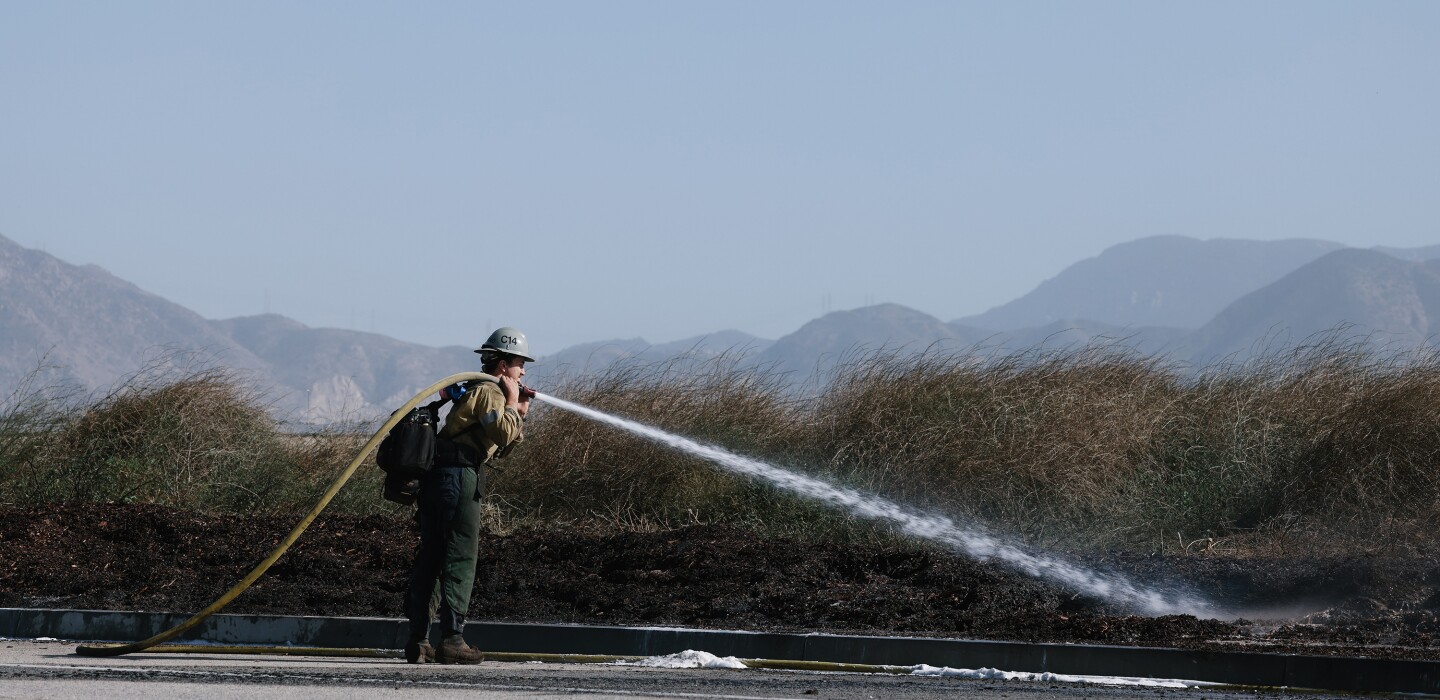
Quick-Moving Flames Ignite as Santa Ana Winds Raise Danger
(TNS) – The season’s first Santa Ana wind event was expected to last through Monday night, and it brought dangerous fire conditions to Southern California. Several small brush fires ignited Sunday across Los Angeles and Ventura counties, and a major fire erupted Monday in Riverside County.
High winds and low humidity increased the fire risk and brought the threat of preventive power shutoffs to almost 70,000 customers in L.A. and Ventura counties, according to Southern California Edison.
Most of the blazes that ignited Sunday — including in West Hills, North Hollywood, Wilmington, Santa Ana and Camarillo — appeared to be contained or under control by Monday morning, with none exceeding more than a couple of acres, fire officials said.
“Right now we’re fortunate we haven’t seen any larger fires,” Robbie Munroe said Monday morning. But the National Weather Service meterologist cautioned, “That’s something we could see on a day like today. With the strong winds and very dry conditions, rapid fire growth can occur.”
By late Monday, those concerns were realized in Riverside County, where a blaze dubbed the Highland fire ballooned to more than 1,200 acres near Aguanga, prompting evacuation orders.
But even with the historically dangerous offshore wind pattern, UCLA climate scientist Daniel Swain said he expected any fire activity to remain more limited compared with prior years because of one key factor: moist fuels.
“The lack of exceptionally dry vegetation makes firefighting much more tractable,” Swain said at a virtual briefing Monday. “The fuels are providing a bit of impediment.”
This year’s unexpectedly wet weather — which included a record-setting snowpack and a summer tropical storm — has helped keep wildfires at bay across the state, Swain said, even when facing the latest warm, dry wind events.
“You can get extreme fire weather conditions from low humidity and strong winds, but if the vegetation isn’t dry enough to support extreme fire behavior, you often aren’t going to get it,” he said.
Santa Ana winds up to 70 mph blew into the region Sunday. At the Magic Mountain Truck Trail in the San Gabriel Mountains, the strongest gust was recorded at 104 mph early Monday, according to the National Weather Service.
A red flag warning — an alert for dangerous fire weather — was set to remain in effect through 10 p.m. Monday for much of L.A. and Ventura counties, with concerns of widespread wind gusts around 40 to 60 mph in the mountains, valleys and some coasts along the the Santa Ana wind corridor, and isolated gusts near 70 mph.
When gusts exceed 58 mph, Munroe said, downed trees and power lines become a major concern, as does road travel for high-profile vehicles. The city of Los Angeles remained under red flag parking restrictions, limiting street parking in designated areas to ensure emergency vehicles can quickly respond.
Winds were expected to be the strongest in the western San Fernando Valley and the Santa Clarita Valley.
High winds are also a concern through Tuesday in the Inland Empire, San Bernardino and Riverside county mountains, San Gorgonio Pass near Banning, the Santa Ana Mountains and inland Orange County.
“We are expecting the worst of the winds through this afternoon, especially early afternoon,” Munroe said Monday morning. “Then we should be on a downward trend this afternoon and evening.”
Thousands in Ventura County were either already without power or imminently threatened to lose power, due to public safety power shutoffs during the wind event, according to the county’s online emergency dashboard.
Southern California Edison said about 2,000 customers in San Bernardino were without power due to the safety shutoffs, as well as about 500 in L.A. and Ventura counties, and thousands more were under alert for possible shutoffs.
A freeze warning was also issued for Tuesday morning for the Antelope Valley.
Swain says he is increasingly confident that this year will remain a relatively calm fire year, given that high fuel moisture. But he said that’s no indication of California’s future. The state is likely to continue experiencing a type of climate whiplash in the face of global warming — with extremely dry years followed by exceptionally wet seasons.
“Inevitably, the pendulum is going to swing back the other way,” Swain said. “Unfortunately, 2017, 2018, 2019, 2020 — these terrible fire years — I don’t think those were an anomaly or a blip. … We will be back there a few years from now, and we could be in a worse place at some point in the future.”
___
©2023 Los Angeles Times. Visit at latimes.com. Distributed by Tribune Content Agency, LLC.


Average Rating